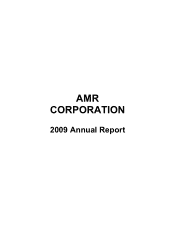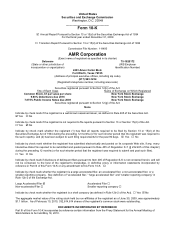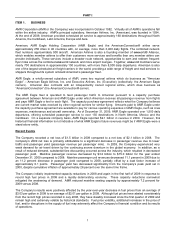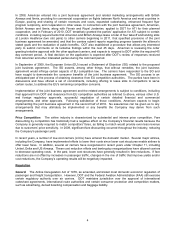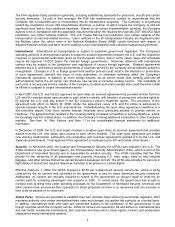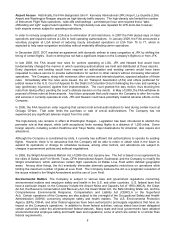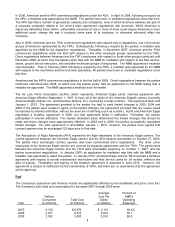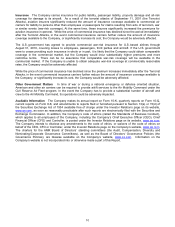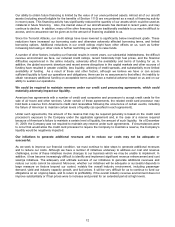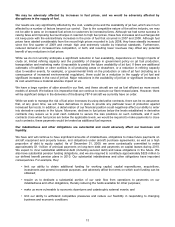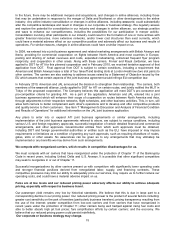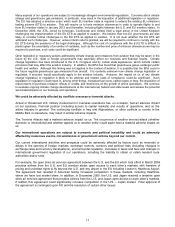American Airlines 2009 Annual Report Download - page 10
Download and view the complete annual report
Please find page 10 of the 2009 American Airlines annual report below. You can navigate through the pages in the report by either clicking on the pages listed below, or by using the keyword search tool below to find specific information within the annual report.
7
The ANCA recognizes the rights of airport operators with noise problems to implement local noise abatement
programs so long as they do not interfere unreasonably with interstate or foreign commerce or the national air
transportation system. Authorities in several cities have promulgated aircraft noise reduction programs, including
the imposition of nighttime curfews. The ANCA generally requires FAA approval of local noise restrictions on
aircraft. While the Company has had sufficient scheduling flexibility to accommodate local noise restrictions
imposed to date, the Company’s operations could be adversely affected if locally-imposed regulations become
more restrictive or widespread.
Many aspects of the Company’s operations are subject to increasingly stringent environmental regulations.
Concerns about climate change and greenhouse gas emissions, in particular, may result in the imposition of
additional legislation or regulation. For example, the EU recently approved measures that impose emissions limits
on airlines with operations to, from or within the EU as part of an emissions trading system beginning in 2012.
The Company is continuing to assess the potential costs of the EU measures. Such legislative or regulatory
action by the U.S., state or foreign governments currently or in the future may adversely affect the Company’s
business and financial results. See Item 1A, Risk Factors, for additional information.
The environmental laws to which the Company is subject include those related to responsibility for potential soil
and groundwater contamination. The Company is conducting investigation and remediation activities to address
soil and groundwater conditions at several sites, including airports and maintenance bases. The Company
anticipates that the ongoing costs of such activities will be immaterial. The Company has also been named as a
potentially responsible party (PRP) at certain Superfund sites. The Company’s alleged volumetric contributions at
such sites are small in comparison to total contributions of all PRPs and the Company expects that any future
payments of its share of costs at such sites will be immaterial.
Labor
The airline business is labor intensive. Wages, salaries and benefits represented approximately 33 percent of the
Company’s consolidated operating expenses for the year ended December 31, 2009. The average full-time
equivalent number of employees of the Company’s subsidiaries for the year ended December 31, 2009 was
78,900.
The majority of these employees are represented by labor unions and covered by collective bargaining
agreements. Relations with such labor organizations are governed by the Railway Labor Act (RLA). Under this
act, the collective bargaining agreements among the Company’s subsidiaries and these organizations generally
do not expire but instead become amendable as of a stated date. If either party wishes to modify the terms of any
such agreement, it must notify the other party in the manner prescribed under the RLA and as agreed to by the
parties. Under the RLA, after receipt of such notice, the parties must meet for direct negotiations, and if no
agreement is reached, either party may request the NMB to appoint a federal mediator. The RLA prescribes no
set timetable for the direct negotiation and mediation process. It is not unusual for those processes to last for
many months, and even for several years. If no agreement is reached in mediation, the NMB in its discretion may
declare at some time that an impasse exists, and if an impasse is declared, the NMB proffers binding arbitration to
the parties. Either party may decline to submit to arbitration. If arbitration is rejected by either party, a 30-day
―cooling off‖ period commences. During that period (or after), a Presidential Emergency Board (PEB) may be
established, which examines the parties’ positions and recommends a solution. The PEB process lasts for 30
days and is followed by another ―cooling off‖ period of 30 days. At the end of a ―cooling off‖ period, unless an
agreement is reached or action is taken by Congress, the labor organization may exercise ―self-help,‖ such as a
strike, and the airline may resort to its own ―self-help,‖ including the imposition of any or all of its proposed
amendments and the hiring of new employees to replace any striking workers.
In April 2003, American reached agreements (the Labor Agreements) with its three major unions: the Allied Pilots
Association (the APA) which represents American’s pilots, the Transport Workers Union of America (AFL-CIO)
(the TWU), which represents seven different employee groups, and the Association of Professional Flight
Attendants (the APFA), which represents American’s flight attendants. The Labor Agreements substantially
moderated the labor costs associated with the employees represented by the unions. In conjunction with the
Labor Agreements, American also implemented various changes in the pay plans and benefits for non-unionized
personnel, including officers and other management (the Management Reductions). The Labor Agreements
became amendable in 2008 (although the parties agreed that they could begin the negotiations process as early
as 2006).

